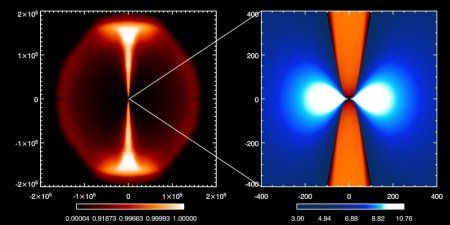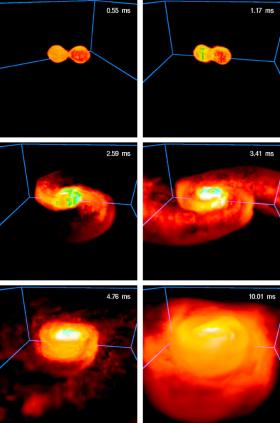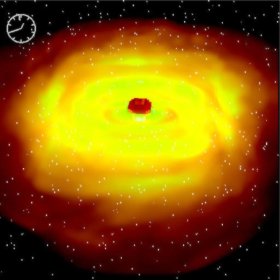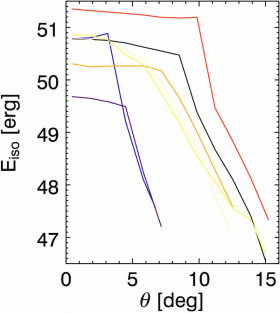|
|  |
Gamma-ray bursts are among the most energetic and
most luminous explosions in the Universe. They occur
roughly once a day, last from a few thousandths of a
second to a few hundred seconds, and come from all
different directions of the sky. Their gamma radiation
is more energetic than visible light and can be
measured by satellites orbiting the Earth in space.
The energy set free by the bursts in just one second
is comparable to the energy production of the Sun during
its whole life.
The more than 2700 observed bursts are grouped into two
distinct classes, one of which are the so-called long
bursts that emit gamma radiation for more than two seconds,
and the other one are the short bursts with durations up
to two seconds.
So far only long bursts could be
observed in much detail. The detection of associated
afterglows in X-rays, visible light and at radio wavelengths
allowed the determination of their distances and confirmed
their origin from host galaxies at large redshifts, i.e.,
typically hundreds of millions to billions of light years
away. Until recently the source of these bursts was a mystery.
But evidence has accumulated that they are death throes that
accompany the catastrophic explosions which end the lives of
very massive stars. A final confirmation of this
conjecture was provided by  GRB030329, a gamma-ray burst which
was detected on March 29, 2003, by GRB030329, a gamma-ray burst which
was detected on March 29, 2003, by  HETE, NASA's High-Energy
Transient Explorer satellite. For the first time this burst
could unambiguously be identified as HETE, NASA's High-Energy
Transient Explorer satellite. For the first time this burst
could unambiguously be identified as  linked to a peculiar
supernova named SN 2003dh at a distance of about two billion
light years. linked to a peculiar
supernova named SN 2003dh at a distance of about two billion
light years.
But where does the gigantic energy come from which powers the
gamma-ray burst? Scientists have coined the theory that the "engine"
is a rapidly spinning black hole which forms when the central core of
a dying star becomes unstable and collapses under its own gravity.
This newly formed black hole then swallows much of the infalling
stellar matter and thereby releases enormous amounts of energy in two
"jets". These expand "highly relativistically", i.e. with almost the
speed of light, along the rotation axis of the star. Before they break
out from the stellar surface, they have to drill their way through
thick layers of stellar material, thus getting collimated into very
narrow beams with an opening angle of only a few degrees (see  Current Research -- March 2000). Indeed,
observations not only confirm the origin of long gamma-ray bursts from
exploding massive stars, but also provide evidence that the gamma
emission comes from narrowly collimated, ultrarelativistic jets with
velocities of more than 99.995 per cent of the speed of light. Current Research -- March 2000). Indeed,
observations not only confirm the origin of long gamma-ray bursts from
exploding massive stars, but also provide evidence that the gamma
emission comes from narrowly collimated, ultrarelativistic jets with
velocities of more than 99.995 per cent of the speed of light.
 |
|
Fig. 3: Gas outflow from the accretion torus more than half
a second after the onset of the energy release at
the black hole. The axial jets (bright white
regions) with velocities above 99.995 per cent
of the speed of light have reached a distance of
more than 150000 kilometers. These ultrarelativistic
outflows cause gamma-ray bursts at much larger
distances. The gas ejected off axis
is much less energetic and slower; it has a velocity
of typically less than 98 per cent of the speed of
light (red regions). The right panel shows a zoom
of the close vicinity of the central black hole
(out to a radius of about 400 km) with the base
of the jets and the extended accretion torus.
Whitish regions indicate gas densities above about
1000 tons per cubic centimeter.
MOVIES:
These movies show the evolution of the ultrarelativistic
jets and of the accretion torus. In case A energy is released at the black hole only for
a tenth of a second and in case B the energy release
is continuous, but decreasing steeply with time.
The movies are in AVI/Xvid format and be viewed using
e.g.  mplayer. mplayer.
|
Rotating, growing stellar mass black holes are also born in
other cosmic events, for example in the violent mergers
encountered by binary neutron stars (Fig. 1) or a neutron star
and a black hole (Fig. 1) after hundreds of millions
of years of inspiral, driven by the emission of gravitational
waves. The remnant of such a catastrophy is a stellar-mass
black hole sucking matter from a girding,
thick torus of gas (Fig. 2).
Such events have long been considered as possible sources of
gamma-ray bursts, and they are still hot candidates for bursts
of the short type, which so far could not be studied by
observations in the same way as bursts from dying stars.
Researchers at the Max-Planck-Institute for Astrophysics
have now developed better computer models that take into account
effects due to Einstein's theory of relativity. Their simulations
can follow the highly relativistic ejection of matter that is
caused by energy release (e.g., due to particle reactions) in the
close vicinity of the black hole. The calculations confirm that
short bursts have properties that are distinctively different
from those of long bursts. Since the black hole--torus system
is not buried inside of many solar masses of stellar material
as in case of dying stars, the polar jets do not have to make
their ways through dense stellar layers and quickly reach
extremely high velocities (Fig. 3).
As a consequence, they are strongly collimated by the presence
of the accretion torus, but their opening angles are somewhat
larger than those measured for long bursts, typically around
5 to 10 degrees (Fig. 3). The models predict that outside
of these polar cones gamma emission should become very weak (Fig. 4)
so that a gamma-ray burst will be observable only from
one out of hundred mergers when the ultrarelativistic jet
is sent towards Earth. The models also
suggest that short bursts can be nearly as bright as long
bursts, although their total energy release is 100 times
lower.
Previous gamma-ray satellites were unable to make precise
measurements for short bursts, but there is hope that
these predictions can be tested soon. The Swift Gamma-Ray Burst
Explorer, a NASA mission with international participation,
is scheduled for launch in the fall of 2004. One of its
prime goals is to unravel the mysteries of the short bursts.
H.-Thomas Janka, M.A. Aloy, E. Müller
Literature:
S. Setiawan. M. Ruffert und H.-Th. Janka, Monthly Not. R.
Astron. Soc., 352, 753--758 (2004)
M.A. Aloy, H.-Th. Janka und E. Müller (2004),
Astron. Astrophys., submitted (astro-ph/0408291).
|



